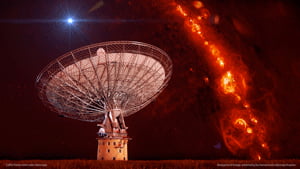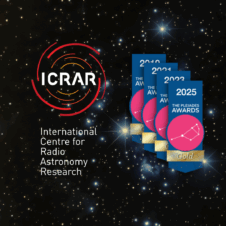New extra-galactic radio bursts to probe Universe

An image showing the Parkes telescope with a ‘radio burst’ flashing in the sky. The red background is gas in our galaxy. Credit: Swinburne Astronomy Productions, vr.swin.edu.au.
The detection of four short bursts of radio waves, probably arising from highly energetic explosions from billions of light years away, has now laid doubts about the authenticity of a heatedly debated previous signal, known as the Lorimer burst, to rest.
Furthermore, these Fast Radio Bursts might enable us to measure the amount of normal matter in the Universe by counting the number of electrons between us and the origin of the bursts.
The international team of researchers, whose paper is now published in the journal Science, rule out any terrestrial sources for these signals but conclude that they must stem from when the Universe was only half its current age.
Curtin University co-author Dr Ramesh Bhat said “The burst energetics suggest that they originate from extreme astrophysical events involving relativistic objects such as neutron stars or black holes.”
Read more from CAASTRO, including media contacts.
Dr Ramesh Bhat is also a research fellow at the International Centre for Radio Astronomy Research.
Video from CAASTRO and Swinburne Astronomy Productions

